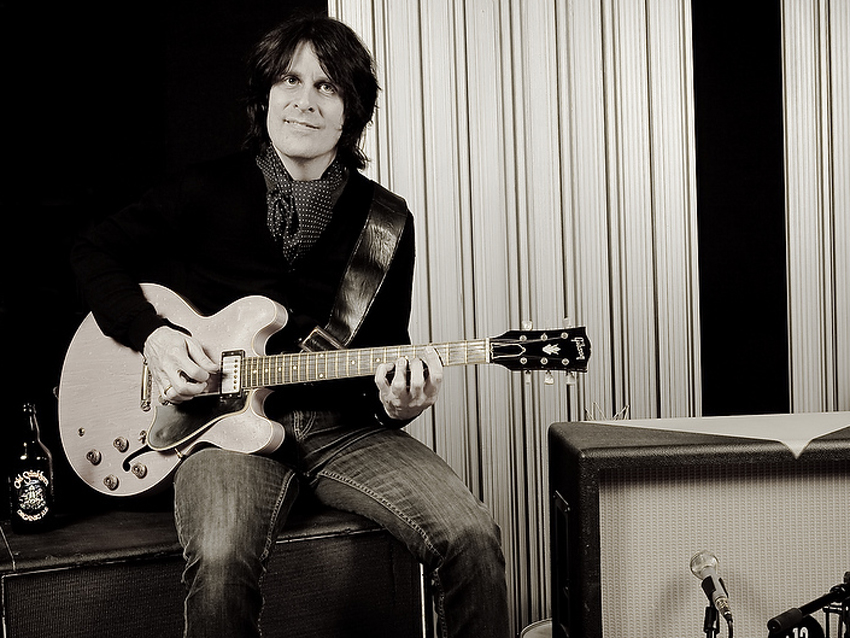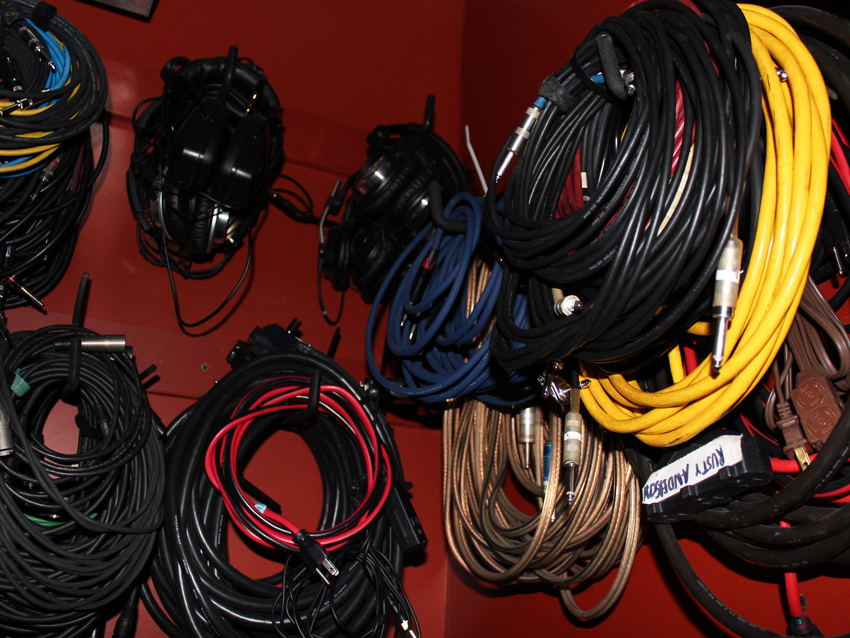
Rusty Anderson's home studio
“I started building it 2005,” says Paul McCartney guitarist Rusty Anderson of his Los Angeles home recording studio that he jokingly refers to as ‘The Dungeon.’
“Whether you have a commercial studio or your own place, it’s always a work-in-progress. Eventually, you have to say, ‘That’s it, we’re done.’ Otherwise, you’ll have contractors knocking down walls day and night.
“I ended up having to build a separate garage for cars, because the original garage and the basement are connected – and that’s what makes up the studio. But I did wire the car garage as an echo chamber, so that room is ready to rock, as well.
“The control room, the machine room and the iso room are in the basement, and the tracking room is basically the attached original garage. It’s a great setup, but it did take a while to get everything functional.”
In addition to his role as guitarist for Paul McCartney, a spot he's held down since 2001, Anderson has released three well-received solo albums - Undressing Underwater, Born On Earth and the newest, Until We Meet Again. The latter is a remastered compilation of the first two discs with a bonus track of the same name. "I've been working on recordings for the next album between touring with Paul and hanging with my eight-month-old daughter," says Anderson.
Time is at a premium, but the guitarist isn't complaining. Playing arenas and stadiums with a rock icon is, according to Anderson, "the gig of a lifetime, and it keeps on going. We just did a European tour and the Grammys, and we’re going to do some more European stuff soon. It's all wonderful.”
You can visit Rusty Anderson on Facebook here, and you can purchase Until We Meet Again here (physical) and here (download).
In the meantime, let's check out Rusty's home studio. "It's cleaned up somewhat," he says, laughing. "Usually, there's cables and things all around. You got me on a good day."

Control room
“Lots of good stuff in here. I use Pro Tools HD and Apogee converters - the converters sound better than the computer sound card. Monitor-wise, I switch between a pair of Barefoot speakers, Yamaha NS-10s and tiny Optima speakers.
“In the rack on the left is a bunch of gear made by Retro: a 2A3, which is a Pultec-style equalizer; a Stay-Level compressor; and a Retro 176 compressor. Underneath those is a DVD player and a Tascam CD player.
“Next to the patch bay are a couple of Helios modules. They’re vintage, like the kind used in the Rolling Stones’ mobile truck back in the day.
“On the top rack on the right are a couple of BAE 1028 mic pre/EQ modules, a Urei 1176 limiter and a Teletronix LA-2A compressor. Next to those are two Neve compressors out of a Neve mixing board.
“Under those items we’ve got a Brent Averill mic pre, which is from parts of a Neve 1272; a Brent Averill 1073 mic pre; and then there’s an API rack of equalizers. Next to that is a Brent Averill/API rack of mic pre's. Going down from there are GML 8200 mastering EQs – they're kind of the industry standard. Below them are two Empirical Labs Distressors, and below those is a Transient Designers by SPL Finally, we have an Alan Smart stereo compressor and a Drawmer noise gate.
"Next to that rack is another one with a TC reverb and delay and a Filter Factory. Below those units I’ve got two V76M modules made by Telefunken, which are incredible sounding. And then there's two Telefunken V72s and an Aphex Aural Exciter - an old one.
“On the wall I have two props from a movie set that a friend gave to me. Hey, it is Hollywood, you know?”

Tracking room
“The bass drum is a 1963 Ludwig White Pearl, and the toms are two Vistalites. I change up my snares sometimes, alternating between Black Beauty and Supra-Phonics. The cymbals are Zildjian Dark Ks.
“The Vibraphone is a Deagan, a four-octave version. It needs a little oil, actually. The cab is a Divided By 13, and the amp is a ’65 Fender Blackface Deluxe. At the other side of the room, I have a Leslie 145 speaker that goes with the Hammond H111 that I modified.
“There’s some Yorkville PA speakers up top, and the baffling is RPG. I had to rip all the insulation out of the walls because it made the room too dead.”

Iso room
“The mic is a Shure SM7. There’s fancier mics, but I really like this one. A lot of people have the SM7s. They’re not that expensive, but they sound really good.
“On the floor, I have a ’57 Fender Tweed Champ, and on the other side is an Ampeg B-15 bass amp. You can use the Ampeg for guitar. If you mic it right, it sounds great – a little bit on the dark side.”

Machine room
“On the bottom is Mytek Private Q, which allows people to adjust their own headphone mixes. I also have some power amps for the phones and some Yamaha NS-10 speakers.
“I absolutely love that tape machine. I use it to mix onto. It’s an Ampex ATR-102 mastering recorder from the late ‘70s.
“Beneath the Ampex is a floor tom from a baby Ludwig kit. I actually use it to record with. The thing is tiny, but it sounds great, and it’s very controllable.”

Just a few guitars and amps
“I have a bunch of guitars at the house, and certain things are in cartage. There’s live guitars and studio guitars. Here’s a few I happened to have on me at the moment.
“First up, we’ve got a Leach custom-made acoustic. Next to that is my main Gibson 335 – this one is from 1965 or ’66. It’s an amazing guitar. Then we have a really cool Duesenberg. It’s got a wang bar, kind of a hi-tech Bigsby. And finally, there’s a ’57 Tele, which is pretty great.”
“I have a lot of amps, but right here’s a Vox AC30 head from 1965, and then there’s Divided By 13 915. Under that is an early ‘70s Marshall Super Bass, and last but not least, a Laney Supergroup from the early ‘70s.”

Cables and headphones
“I’ve gone through so many cables. These cables all use Mogomi wire – and basically, my whole studio is wired with Mogami. It’s something of an industry standard, but I do think the quality is fantastic.
“I’ve also tried many, many headphones. Right now, I’m using Ultrasones, and they seem to be pretty good.”
Joe is a freelance journalist who has, over the past few decades, interviewed hundreds of guitarists for Guitar World, Guitar Player, MusicRadar and Classic Rock. He is also a former editor of Guitar World, contributing writer for Guitar Aficionado and VP of A&R for Island Records. He’s an enthusiastic guitarist, but he’s nowhere near the likes of the people he interviews. Surprisingly, his skills are more suited to the drums. If you need a drummer for your Beatles tribute band, look him up.

